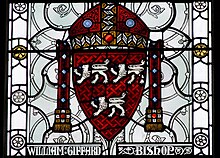William Giffard (d. 1129), was the Lord Chancellor of William II and Henry I, from 1093 to 1101, and Bishop of Winchester (1100–1129).
William Giffard | |
|---|---|
| Bishop of Winchester | |
 Victorian-era reconstruction of the coat of arms of William Giffard, from the Winchester Great Hall | |
| Appointed | 3 August 1100 |
| Term ended | 23 January 1129 |
| Predecessor | Walkelin |
| Successor | Henry of Blois |
| Orders | |
| Consecration | 11 August 1107 by Anselm of Canterbury |
| Personal details | |
| Died | 23 January 1129 |
| Buried | Winchester Cathedral |
| Denomination | Catholic |
| Lord Chancellor | |
| In office 1093–1101 | |
| Monarchs | |
| Preceded by | Robert Bloet |
| Succeeded by | Roger of Salisbury |
Family and early life
editGiffard was the son of Walter and Ermengarde, daughter of Gerard Flaitel.[1] Giffard was the brother of Walter and the sister of Rohese, wife of Richard fitz Gilbert.[1][2]
He held the office of Dean of Rouen.[3]
Lord Chancellor
editGiffard was Lord Chancellor under William II and Henry I from 1093 to 1101.[4]
Bishop of Winchester
editOn 3 August 1100 he became bishop of Winchester[5] by nomination of Henry I.[2][6] Henry nominated him probably in an attempt to win the support of the clergy in Henry's bid to claim the throne directly after the death of William Rufus.[7] He was one of the bishops elect whom Archbishop Anselm of Canterbury refused to consecrate in 1101 as having been nominated and invested by the lay power.[8]
During the investitures dispute Giffard was on friendly terms with Anselm and was banished for declining to accept consecration from Gerard Archbishop of York in 1103. He was, however, one of the bishops who pressed Anselm, in 1106, to give way to the king. He was finally consecrated after the settlement of 1107 on 11 August,[5] and became a close friend of Archbishop Anselm.[8] As bishop, William aided the first Cistercians to settle in England, when in 1128 he brought monks from L'Aumône Abbey in France to settle at Waverley Abbey.[9] He also restored Winchester Cathedral with great magnificence.[8]
Among Giffard's actions as bishop was the refounding of a religious house at Taunton and the staffing of it with Austin canons. The canons were drawn from Merton Priory.[10] He was known for the close and good relations that he had with the monks of his cathedral chapter, sharing their meals and sleeping with them instead of in his own room.[11]
Death
editGiffard died shortly before 25 January 1129, the date he was buried.[12]
References
edit- ^ a b Keats-Rohan, Katharine Stephanie Benedicta (1999). Domesday people: a prosopography of persons occurring in English documents, 1066-1166. Woodbridge: the Boydell press. p. 456. ISBN 978-0-85115-722-1.
- ^ a b Hollister, C. Warren (1973). "The Strange Death of William Rufus". Speculum. 48 (4): 637–653. doi:10.2307/2856221. ISSN 0038-7134. JSTOR 2856221.
- ^ Spear, David S. (1982). "The Norman Empire and the Secular Clergy, 1066-1204". Journal of British Studies. 21 (2): 7. doi:10.1086/385787. ISSN 0021-9371. S2CID 153511298.
- ^ Fryde, E. B., ed. (2003). Handbook of British chronology (3rd ed.). Cambridge: Cambridge University Press. p. 83. ISBN 978-0-521-56350-5.
- ^ a b Fryde, E. B., ed. (2003). Handbook of British chronology (3rd ed.). Cambridge: Cambridge University Press. p. 276. ISBN 978-0-521-56350-5.
- ^ Franklin, M. J. (23 September 2004). "Giffard, William (d. 1129), bishop of Winchester". Oxford Dictionary of National Biography (online ed.). Oxford University Press. doi:10.1093/ref:odnb/10655. Retrieved 13 February 2024. (Subscription or UK public library membership required.)
- ^ Teunis, Henry B. (1978). "The coronation charter of 1100: a postponement of decision. What did not happen in Henry I's reign". Journal of Medieval History. 4 (2): 138. doi:10.1016/0304-4181(78)90003-9. ISSN 0304-4181.
- ^ a b c Chisholm, Hugh, ed. (1911). . Encyclopædia Britannica. Vol. 12 (11th ed.). Cambridge University Press. p. 4.
- ^ Burton, Janet (2000). Monastic and religious orders in Britain: 1000 - 1300. Cambridge medieval textbooks. Cambridge: Cambridge University Press. p. 69. ISBN 978-0-521-37797-3.
- ^ Burton, Janet (2000). Monastic and religious orders in Britain: 1000 - 1300. Cambridge medieval textbooks. Cambridge: Cambridge University Press. p. 47. ISBN 978-0-521-37797-3.
- ^ Bethell, D. L. (1969). "English black monks and episcopal elections in the II20s". The English Historical Review. LXXXIV (CCCXXXIII): 682. doi:10.1093/ehr/LXXXIV.CCCXXXIII.673. ISSN 0013-8266.
- ^ "WINCHESTER: Bishops | British History Online". www.british-history.ac.uk. Retrieved 13 February 2024.